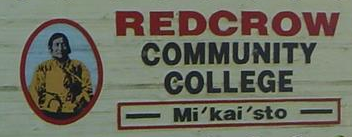Apahtó’kii – Pinus contorta Dougl. ex Loud.

(Photo courtesy of Glenbow Museum Archives NA-3322-21)
“There was once a woman named Last Calf who was riddled with Tuberculosis. While she and her husband were camped near a beaver lodge, she noticed the animal’s tracks in the mud and left some food for it. The beaver took the gift and returned the favor by appearing to her in a vision. He gave her a cure for Tuberculosis. She was to collect the pitch of the lodge pole pine, boil it in water and drink the infusion while uttering a special song. (The song had not words.) Last Calf’s husband was alarmed at this treatment and cautioned her against poisoning but she went ahead and drank the brew. She said she felt as though she were going to die and began vomiting profusely. She drank again with the same result, but the next morning her chest was cleared as never before. Then the infusion was used by everyone to treat tubercular coughs.”
From: Hellson, John C. (1974) Ethnobotany of the Blackfoot Indians. Ottawa. National Museums of Canada. Mercury Series (p. 73)
Apahtó’kii
Apahtó’kii ihtaisaamskao’p ki iikakawoyi ihtapaistotsi’p ihtayisitapiiyo’pistsi. Iitaisaisskssoyiiyaw ksowoohtsi spahkoistsi. Ihtaisokinayaw isttsikssaiskinaiksi. Ni’takaiksamaikowan (Pete Standing Alone) annikkiw iikamo’tsiksimmiksi ki i’naksikkstsiksimmiksi ihtowaanstaamia’tsko’piaw ki ni’toyi tatsikikkonamaan.
Lodgepole pine
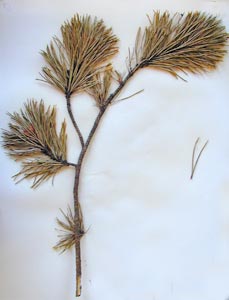
Pinus contorta Dougl. ex Loud.
Galileo Educational Network
The Lodgepole Pine is a tree that gives us medicine and its straight and narrow trunk helps us build many things. The Lodgepole Pine grows on the lower slopes of hills, like the Cypress and Porcupine Hills. It also grows in the mountains. It is an evergreen and can reach a height of 25 metres. The needles are in bunches of two and the cones are 2-5 cm long. The pinecones need heat to release their seeds. It is through fire that the seeds are released and trees can grow again. This is an important lesson for us. Like the Lodgepole Pine, new life is born out of old things dying or burning away.
A healing tea of the Lodgepole pitch was brewed for tuberculosis. Pitch can also be chewed like gum and keeps your breath fresh. Our elders used the pitch as a kind of glue, as well. The pitch was used alot to glue headdresses together and also to waterproof moccasins. Long ago, buffalo parts were boiled in the pitch and this sticky balm was rubbed on bows, to make them both stronger and more flexible.
Elder Pete Standing Alone told us that the straight narrow trunks could be used as tipi poles and as a center lodge pole. The younger trees make the best tipi poles. Lodgepole pines can be used for fence posts, also. Pete told us that before wagons, our people made a travois from the Lodgepoles and this was dragged behind horses to carry things. Our elders used them also to make backrests.
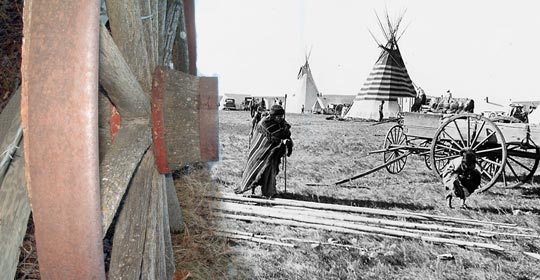
Lodgepole Pine are often used for tipis.
(Photo courtesy of Glenbow Museum Archives NA-667-106)
Pin de Murray
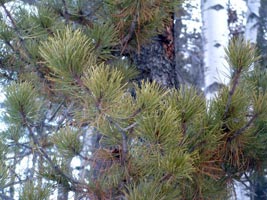
Pinus contorta Dougl. ex Loud.
Galileo Educational Network
Grâce au pin de Murray, nous avons accès à diverses sources de remèdes. Aussi, son tronc droit et étroit nous aide à construire bien des choses. Le pin de Murray pousse dans les collines, comme celles de Cypress et de Porcupine. Il pousse aussi dans les montagnes. Cet arbre à feuillage persistant peut mesurer jusqu’à 25 mètres de haut. Ses aiguilles poussent en groupes de deux et ses pommes de pin mesurent de 2 à 5 centimètres de long. Les pommes de pin ont besoin de chaleur pour relâcher leurs graines. C’est le feu qui fait sortir les graines et qui permet à de nouveaux arbres de pousser. Il s’agit là d’une importante leçon pour nous. Tout comme pour le pin de Murray, nous savons qu’une nouvelle vie peut venir de vieilles choses en train de mourir ou de brûler.
Nos aînés faisaient du thé avec le brai du pin de Murray pour guérir la tuberculose. Le brai peut aussi être mâché comme de la gomme. Il aide à garder l’haleine fraîche. Nos aînés se servaient aussi du brai pour faire une sorte de colle pour coller les coiffes et rendre les moccassins à l’épreuve de l’eau. Jadis, nous faisions bouillir des morceaux de bison dans le brai. Ce baume collant était frotté sur les arcs de flèches afin de les rendre plus forts et souples.
L’aîné Pete Standing Alone nous a dit que les troncs droits et étroits du pin de Murray peuvent servir de piquets et de poteau central pour les tipis. Les meilleurs piquets proviennent des plus jeunes arbres. Le pin de Murray peut aussi faire de bons poteaux de clôture. Pete nous a dit qu’avant l’existence des wagons, notre peuple fabriquait des travois avec le pin de Murray. Ces travois étaient attelés aux chevaux qui transportaient divers objets. Nos aînés se servaient aussi du pin de Murray pour fabriquer des appuis-dos.
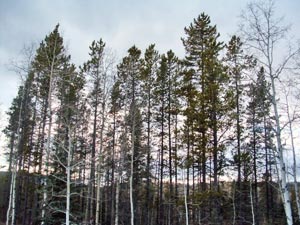
Pinus contorta Dougl. ex Loud.
Galileo Educational Network
- Blackfoot Gallery Committee. (2001). The Story Of The Blackfoot People. Toronto: Keyporter Books.
- Glenbow Museum. (2005). Nitsitapiisinni Exhibit Calgary, Alberta: Blackfoot Gallery Committee.
- Hellson, John C. (1974). Ethnobotany of the Blackfoot Indians. Ottawa: National Museums of Canada.
- Kerik, Joan. (1979). Living With The Land: Use of Plants by the Native People Of Alberta. Edmonton, Alberta: Provincial Museum of Alberta.
- Moerman, Daniel E. (1998). Native American Ethnobotany. Portland: Timber Press.
- Standing Alone, P. (personal communication October 28, 2005) referred to Lodgepole Pine.
- Willard, Terry. (1992). Edible and Medicinal Plants of the Rocky Mountains and Neighboring Territories. Calgary, Alberta: Wildrose College of Natural Healing.



